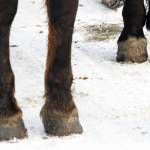Feeding to Avoid Laminitis

Generations of horsemen, including farriers and other hoof-care professionals, understand fully the destructive effects of laminitis. Over the last several years, researchers have revealed that laminitis seems especially commonplace in horses with certain metabolic conditions such as equine Cushing’s disease and equine metabolic syndrome.
In some cases, proper nutritional management of horses prone to or diagnosed with these conditions can keep from developing laminitis.
Equine Cushing’s Disease
Equine Cushing’s disease (ECD) or pituitary pars intermedia dysfunction (PPID) results from a tumor in the pituitary gland and is frequently recognized in older horses. Horses with ECD usually present with one or more of the following signs: a long, curly hair coat regardless of season, excessive thirst and urination, pot-bellied appearance, lethargy, and dental and hoof diseases. From a veterinary perspective, laminitis is probably the most important clinical manifestation of ECD because of the pain that often accompanies the disease and the consequent decrease in the usefulness of the animal.
The best dietary strategy for horses with ECD will depend on several factors. Because these horses tend to be insulin insensitive, a ration that produces a low glycemic response is essential. Rations containing large grain meals and lush pasture should be avoided to reduce the likelihood of laminitis. Additionally, the ration must supply the correct amount of required nutrients for the horse, and it must supply the correct caloric content to maintain or achieve a desired body condition.
Horses diagnosed with ECD that are overweight should be fed a ration composed primarily of hay. Most hays have low glycemic indexes compared to cereal grains and sweet feeds. Hay rations should be supplemented with a low-inclusion fortified balancer to provide nutrients that may be deficient in forage.
If an older horse with ECD has trouble maintaining weight, its ration can be supplemented with additional calories from a high-fat, low-starch product. In addition to providing a concentrated source of energy, vegetable oil has been shown to greatly reduce glycemic response to a grain meal, possibly by delaying gastric emptying. Beet pulp, known as a “super-fiber,” is often added to rations for its caloric density. If this feedstuff is used, it should be rinsed to reduce its glycemic index. Rice bran also has a low glycemic index and is therefore appropriate for horses with ECD.
Feeds designed for senior horses may not be desirable for horses with ECD because they might contain ingredients such as molasses, which in turn produce a high glycemic response. For example, in a recent trial by KER, a popular senior feed had a glycemic index that was similar to oats and therefore inappropriate for a horse with ECD.
In addition to nutritional management, pergolide is the drug of choice for treating ECD. Pergolide increases the production of dopamine, a neurotransmitter that has two potentially beneficial effects: it suppresses the activity of neoplastic pars intermedia cells, and it inhibits growth of tumors.
Equine Metabolic Syndrome
Equine metabolic syndrome (EMS) is an endocrine and metabolic disorder that results in insulin resistance and an increased risk of pasture-associated laminitis. Horses and ponies with EMS tend to be obese with cresty necks. These animals often had prior bouts of laminitis and are easy keepers.
Obese horses should be moved toward a more moderate body condition. A two-prong approach to management of obesity that includes exercise and diet modifications might be best. Horses that are unsound due to laminitis or other problems should not be exercised, but all others can be placed on a conditioning regimen that will help shed excessive weight. Regular exercise is a key factor in reducing the insulin resistance that accompanies this disease.
A feeding program for these horses should be focused on reducing body weight while providing adequate protein, vitamin, and mineral intake. It should be a forage-based program, but pasture intake should either be restricted with a grazing muzzle and limited turnout or completely avoided during times of lush growth because pasture is often rich in sugar. The sugar content of grasses depends on several factors (species of grass, soil type, climate, hours of sunlight, time of day), and large fluctuations in sugar levels are usual. Therefore, it is sometimes difficult to determine sugar levels in any stand of pasture.
Horses with access to pasture should be closely observed for signs of laminitis. It is not uncommon for severely affected horses to be unable to consume pasture of any kind. In these instances, horses should be relegated to a drylot that allows them to move around freely but without access to pasture. Appropriate low-glycemic hay should be offered.
Most horses diagnosed with EMS carry excessive weight. There are some, however, that maintain a more moderate body condition, perhaps due to appropriate exercise or dietary management. Regardless, these individuals typically possess unusual fat deposits on the body, called regional adiposity.
Because caloric restriction is important, a well-formulated concentrated balancer should be used for supplementation.
Aside from obesity and dietary management, metformin is often administered to horses with EMS, though its absorption and efficacy are still being investigated in horses.
One of the simplest ways to help manage metabolic diseases in horses is through dietary manipulation. Though there are no guarantees, reaching out to a qualified equine nutritionist in addition to a veterinarian could reduce the risk of a metabolically challenged horse developing laminitis.








